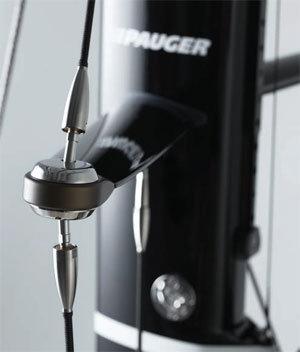

When Pauger Carbon decided to push both performance and elegance to the max with their latest composite standing rigging product they ensured that it was just as easy to retrofit as to install on a new launching
The evolution of fibre standing rigging technology moves fast. Ongoing development in materials and design is starting to produce solutions which, compared with conventional stainless steel rod, are smaller in profile for low windage and lighter in weight for greater stability and less pitch gyradius. The end result is higher performance potential in any new project or retrofit rig scenario. Pauger Carbon’s experience and history with carbon spar manufacturing is now showing exciting promise in their new line of solid carbon rigging.
While carbon rod rigging may not be new, what Pauger Carbon is doing with this material is at the leading edge of development, taking it to new levels of performance. This starts with using an extremely high grade of carbon: while other carbon rod rigging is usually built from Toray T700 as standard and T800 as intermediate modulus, Pauger uses Toray T1100 which is 42 per cent stronger than T700 and 19 per cent stronger than T800. They have also perfected a process of producing a very high-density carbon rod: 80 per cent carbon with only 20 per cent resin. This concentrates the strength into a small footprint, allowing for smaller rod sizes at equivalent strength – an impressive 20 to 30 thinner than other, lower modulus carbon rigging.
The breaking strength is double of the equivalent Nitronic 50 steel rods. In fact, for equivalent Nitronic rods -30 or larger, Pauger Carbon rod is smaller in diameter. This means in making the decision to retrofit to carbon from Nitronic rod rigging there will be little or no sacrifice in windage. This is especially important for superyachts and very large racing boats with their multi-spreader rigs and many diagonal and vertical shrouds – the windage from all that rigging can have a significant and measurable effect on performance.
Pauger Carbon also has a patented technology for end fitting terminations. Their new process allows simpler, faster, more economical production which significantly reduces the cost of the product.
Reducing weight and windage can also improve the performance of more modest-sized racer/cruisers. For example, in the retrofit of a ClubSwan 42 the 63.5kg weight of the steel backstay and lateral stays is reduced to only 13.7kg when replaced with Pauger Carbon rod of approximately the same diameters.

It’s no wonder these kinds of specifications have received attention from teams that are serious about improving performance, particularly offshore where every kilogram saved aloft translates to miles on the racecourse. Two conventional Imoca 60s competing in the last Route du Rhum replaced their previous PBO rigging with Pauger carbon to support their spars.
Another example is Black Pepper Code 3, a classy 72ft racing yacht. Pauger Carbon not only provided the carbon rigging but also the mast and boom – and they built the complete carbon structure of the hull and deck. The breaking strength of Code 3’s V1s compared with Nitronic stainless steel is 63.5 tons versus 41.2 tons. The weight in Pauger Carbon rod is 25.1kg versus 155.4kg in Nitronic – more than 80 per cent lighter – and the V1 rod diameter is 17.8mm (with cover) in Pauger carbon and 19.5 in Nitronic.
The complete weight of the standing rigging for Code 3 is only 50kg using optimised Pauger carbon rod with custom titanium fittings. This compares with 210kg in Nitronic 50 stainless steel rod with stainless steel fittings.
In some retrofit scenarios the existing rod rigging interfaces are not in need of replacement. This is no problem for Pauger Carbon because versatile solutions can be found to fit the new carbon rod to work with existing turnbuckles, tip cups, and cap tangs.
Another important feature of Pauger carbon rods is that they can be coiled, unlike some other solid carbon rod products that must be transported at full length. For example, a 10mm diameter carbon rod can be reduced to just a 150 cm wide coil. This vastly simplifies the assembly process of new and retrofitted spars.
And finally, there is yet another important feature to Pauger carbon rigging compared with other rigging types: longevity. With appropriate care and regular maintenance, their carbon rod rigging can last as long as a carbon spar: Pauger Carbon estimates this at 15 years or more. So an upgrade investment made in Pauger carbon rigging will keep paying dividends in performance for what may be the entire competitive life of the yacht.
Click here for more information on Pauger Carbon »
We invite you to read on and find out for yourself why Seahorse is the most highly-rated source in the world for anyone who is serious about their racing.
To read on simply SIGN up NOW
Take advantage of our very best subscription offer or order a single copy of this issue of Seahorse.
Online at:
www.seahorse.co.uk/shop and use the code TECH20
Or for iPad simply download the Seahorse App at the iTunes store


